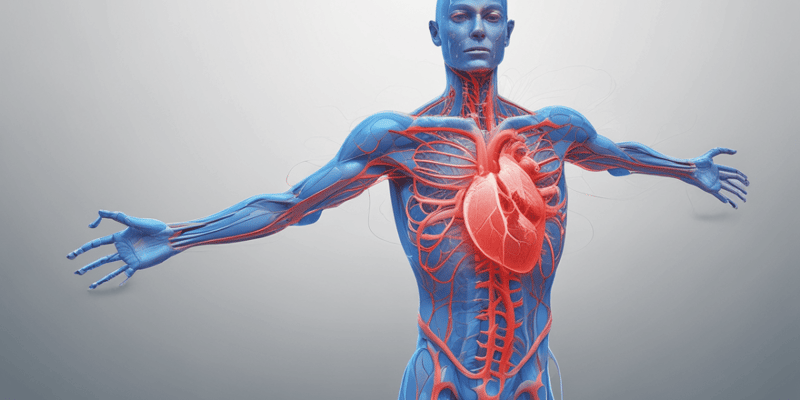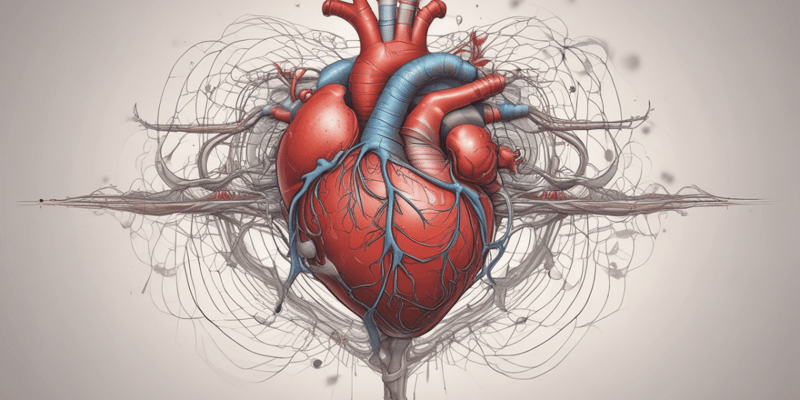36 Questions
What is the primary reason for the steepest drop in blood pressure occurring in arterioles?
High peripheral resistance in arterioles
What is the relationship between blood flow and pressure gradient?
Blood flow is directly proportional to the pressure gradient
What is the result of high blood pressure in capillaries?
Rupture of fragile, thin-walled capillaries
What is the relationship between blood flow and peripheral resistance?
Blood flow is inversely proportional to peripheral resistance
What is the main function of valves in the circulatory system?
To prevent backflow of blood
What is the mean arterial pressure (MAP)?
The pressure that propels the blood to the tissues
What is the term for the volume of blood flowing through a vessel or the entire circulation in a given period?
Blood flow
What is the primary factor in maintaining blood pressure throughout the circulatory system?
The pumping action of the heart
What is the main factor that provides the driving force for blood to move through the circulatory system?
Blood pressure
What is the term for the measure of the amount of friction blood encounters in the peripheral systemic circulation?
Peripheral resistance
Which of the following increases peripheral resistance?
Increased blood viscosity
What is the unit of measurement for blood pressure?
mm Hg
What is the primary function of the vasomotor center in regulating blood pressure?
To maintain vasomotor tone, which is a moderate constriction of arterioles
Which of the following hormonal controls of blood pressure would be most active during a severe hemorrhage?
Antidiuretic hormone
Baroreceptors are located in which of the following areas?
Carotid sinuses and walls of large arteries of the neck and thorax
Which of the following is NOT a short-term mechanism of neural control of blood pressure?
Renal regulation
What is the effect of increased cardiac output on blood pressure?
It increases blood pressure by increasing the velocity of blood flow
What is the result of the combined action of the neural and hormonal controls of blood pressure?
A maintaining of blood pressure and cardiac output
What is the primary reason for the pulsatile nature of blood pressure near the heart?
The pumping action of the heart
Which of the following factors contributes to the low pressure in capillaries?
The permeability of capillaries
What is the effect of an increase in cardiac output on the pressure gradient in the circulatory system?
It increases the pressure gradient
What is the primary factor that aids venous return in the circulatory system?
The pumping action of the heart
What is the relationship between pulse pressure and systolic pressure?
Pulse pressure is the difference between systolic and diastolic pressure
What is the effect of an increase in peripheral resistance on the mean arterial pressure (MAP)?
It increases the MAP
What is the primary factor that contributes to the relative constancy of blood flow in the entire vascular system?
Cardiac output
In which type of blood vessels is the pressure gradient most significant?
Large arteries near the heart
What is the primary function of valves in the circulatory system, particularly in the veins of the limbs?
Preventing backflow of blood
Which of the following factors does not directly affect blood pressure in the circulatory system?
Cardiac output
What is the unit of measurement for the volume of blood flowing through a vessel or the entire circulation in a given period?
ml/min
Which of the following factors increases peripheral resistance, thereby affecting blood pressure?
Increased blood viscosity
What is the primary mechanism by which the respiratory 'pump' contributes to venous return?
Expansion of thoracic veins during inspiration
Which of the following factors does NOT directly influence cardiac output?
Arterial blood pressure
During intense exercise, which of the following mechanisms is most likely to be activated to increase blood pressure?
Neural control of vasomotor tone
What is the net effect of atrial natriuretic peptide (ANP) on blood pressure?
Decreases blood pressure by causing vasodilation
Which of the following statements is TRUE about the relationship between cardiac output and peripheral resistance?
Cardiac output and peripheral resistance are inversely proportional
What is the primary function of the cardiovascular center in regulating blood pressure?
To integrate neural and hormonal controls of blood pressure
Study Notes
Blood Vessel Diameter and Resistance
- Smaller tube diameter = greater resistance
- Fluid is slower at walls, faster in center
- Small-diameter arterioles are a major factor in resistance
Relationship Between Blood Flow, Blood Pressure, and Resistance
- Blood flow is directly proportional to the pressure gradient
- If blood flow increases, pressure increases
- Blood flow is inversely proportional to peripheral resistance
- If resistance increases, blood flow decreases
Systemic Blood Pressure
- The pumping action of the heart generates blood flow
- Pressure results when flow is opposed by resistance
- Blood pressure near the heart is pulsatile (BP rises and falls)
- Systemic pressure is highest in the aorta, declines throughout the pathway, and is 0 mm Hg when returning to the heart at the right atrium
- The steepest drop occurs in arterioles
Blood Pressure throughout the Circulatory System
- Arterial Blood Pressure:
- Systolic pressure: pressure exerted during ventricular contraction
- Diastolic pressure: lowest level of arterial pressure during ventricular relaxation
- Pulse pressure = difference between systolic and diastolic pressure
- Mean arterial pressure (MAP): pressure that propels the blood to the tissues
- Pulse Points:
- Capillary Blood Pressure: low capillary pressure is desirable, high BP would rupture fragile, thin-walled capillaries
- Venous Blood Pressure: changes little during the cardiac cycle, small pressure gradient, about 15 mm Hg, low pressure due to cumulative effects of peripheral resistance
Factors Aiding Venous Return
- Valves prevent backflow of blood
- Most abundant in veins of the limbs
- Veins
Physiology of Circulation: Definition of Terms
- Blood flow: volume of blood flowing through a vessel, an organ, or the entire circulation in a given period
- Blood pressure (BP): the pressure gradient provides the driving force that keeps blood moving from higher to lower pressure areas
- Resistance (peripheral resistance): measure of the amount of friction blood encounters, generally encountered in the peripheral systemic circulation
Sources of Resistance
- Blood viscosity: the "stickiness" of the blood due to formed elements and plasma proteins, greater viscosity = greater resistance
- Total blood vessel length: longer vessel = greater resistance
- Blood vessel diameter: smaller diameter = greater resistance
Maintaining Blood Pressure
- Requires cooperation of the heart, blood vessels, kidneys, and brain
- Blood pressure = CO x PR (and CO depends on blood volume)
- Blood pressure varies directly with CO, PR, and blood volume
- Changes in one variable are quickly compensated for by changes in the other variables
Control of Blood Pressure
- Short-term controls: neural and hormonal controls
- Long-term controls: renal regulation
- Counteract fluctuations in blood pressure by altering peripheral resistance or blood volume
Short-Term Mechanisms: Neural Controls of Blood Pressure
- Neural controls operate via reflex arcs involving baroreceptors, vasomotor centers, and vasomotor fibers
- Baroreceptors are located in carotid sinuses, aortic arch, and walls of large arteries of the neck and thorax
- Vasomotor center: a cluster of sympathetic neurons in the medulla that oversees changes in blood vessel diameter, maintains vasomotor tone (moderate constriction of arterioles)
- Cardiovascular center: vasomotor center plus the cardiac centers that integrate blood pressure control by altering cardiac output and blood vessel diameter
Short-Term Mechanisms: Hormone Controls of Blood Pressure
- Adrenal medulla hormones: Norepinephrine and epinephrine cause generalized vasoconstriction and increased cardiac output
- Antidiuretic hormone (ADH): causes intense vasoconstriction in cases of extremely low BP
- Atrial natriuretic peptide (ANP): causes blood volume and blood pressure to decline, causes generalized vasodilation
Long-Term Mechanisms: Renal Regulation of Blood Pressure
- Kidneys act directly and indirectly to regulate arterial blood pressure by altering blood volume
Understand the relationships between blood flow, blood pressure, and resistance in the circulatory system. Learn how blood vessel diameter affects resistance and how the heart's pumping action impacts systemic blood pressure.
Make Your Own Quizzes and Flashcards
Convert your notes into interactive study material.
Get started for free



